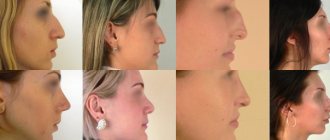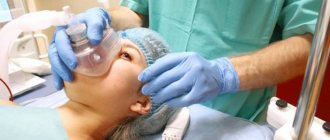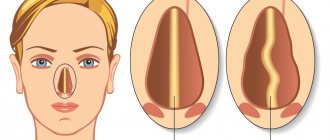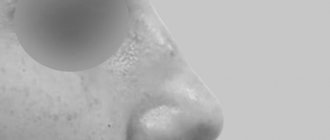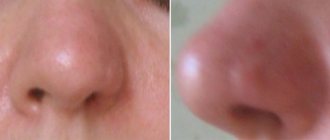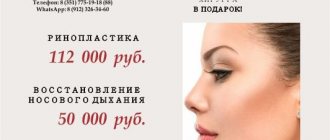Rhinoplasty or nose surgery is an operation to correct the aesthetic and functional components of the nose, depending on the type of operation performed. There are quite a few types of rhinoplasty, but the main and most used are:
- Open rhinoplasty is a method of rhinoplasty with external sutures, and a complete overview of the operating picture for the surgeon. It is more popular and often used due to the high percentage of effectiveness of the operation.
- Rhinoseptoplasty is plastic surgery of the nose with one-stage correction of the nasal septum.
- Septoplasty is the correction of an exclusively deviated nasal septum, without affecting the external structures of the nose.
- Rhinoplasty with osteotomy - correction of the shape of the nose by moving the bones of the base of the nose. It is most often used when it is necessary to correct the size of the nose, various types of curvature of the shape of the nose, hump, etc.
- Closed rhinoplasty is a method of closed rhinoplasty with sutures inside the nose, which are made on the mucous membrane. It is most often used for mini nose corrections that do not require drastic changes.
- Rhinoplasty of the tip of the nose - is performed only on the tip of the nose, working only on the cartilaginous structures.
Dr. Lina Isbir in the process of rhinoplasty
Indications for rhinoplasty can be both aesthetic and medical reasons associated with difficulty breathing or its complete absence.
The presence of a hump of the nose, of varying severity. Curvature of the nose, congenital or acquired as a result of injury. Deviation of the nasal septum. Wide/large and/or asymmetrical nostrils. Wide or asymmetrical tip of the nose. Size of the nose in general, or a wide dorsum of the nose in particular.
Parameters of beautiful nose wings
The wings of the nose are paired, symmetrically arranged cartilages that form the nostrils.
The main parameters of harmoniously formed wings of the nose can be called symmetry and proportionality. When talking about the aesthetics of the olfactory organ, people most often mean a flat back, a neat tip and a moderate projection (length) of the nose. The wings of the nose, due to the fact that they occupy a small area, attract less attention.
The aesthetic configuration of the wings is very important! I can assume that a non-specialist in the field of facial aesthetics is not always able to identify where the “ugliness” of the nose lies. At first glance, everything is not bad, but some element stands out from the well-tailored design. Ugly wings are a touch that can destroy the entire harmony conceived by nature.
They must be symmetrical and proportional to the entire external part of the respiratory organ!
⇒ INFORMATION: How to get rid of a hump on the nose?
The photo was taken immediately after complex rhinoplasty, during which the wings of the nose were also worked on.
Advertising promises rhinoplasty without surgery: cheaper, safer! Hooray? You give injections of a special agent that softens the cartilage, wear a special pad, and the nose is deformed into a given shape. Great solution or cheese in the trap?
Plastic and maxillofacial surgeon Abramyan Solomon Maisovich talks about non-surgical rhinoplasty:
Is it possible to change the shape of the nose by injecting any substance?
I think the wording “non-surgical rhinoplasty” is incorrect.
Injections are nothing more than contour plastic surgery of small (up to 3-5 mm in diameter) defects in the nasal area. For example, you can fill a small dimple with hyaluronic acid filler and call it non-surgical rhinoplasty. Only HA-based fillers do not cause serious complications. I do not administer biopolymers or other solutions to my patients.
But the introduction of fillers is not an independent direction and cannot be a replacement for surgery.
What is “injection rhinoplasty”? Fillers based on hyaluronic acid are injected into the subcutaneous space of the nose. A nose that has been corrected in this way may swell every morning, as hyaluronic acid tends to accumulate fluid. The drug begins to dissolve after 3-6 months and in order to maintain a stable result, the procedure must be repeated 2 times a year. It's unstable and unpredictable.
Another issue is the use of HA-based fillers in the postoperative period. In this case, the drug behaves differently: it dissolves very slowly or does not dissolve at all - it is encapsulated, which allows you to maintain the required volume for a long time.
Is it possible to correct the bridge of the nose with fillers: to lift and straighten the bridge if there is a small hump?
Without surgery, it is impossible to affect the bone. The whole concept of “injection rhinoplasty” is work at the level of subcutaneous tissue, creating additional volume in the tissues.
To smooth out the “ethnic hump,” the doctor subcutaneously applies hyaluronic acid filler from the forehead to the base of the hump, thus lifting the skin. But at the same time, the frontonasal fold disappears, and in some cases the nose starts right from the eyebrows: it becomes cast, heavy, but without a hump. It does not look aesthetically pleasing, the shape is constantly changing, hyaluronic acid may begin to migrate (to the sides, down, to the base) or dissolve. A moderately stable result will last on average for 2-3 months.
As for the possibility of replenishing the missing volume in the area of the bridge of the nose when it is necessary to lift it - yes, this can also be done with the help of fillers. But, again, hyaluronic acid can move, and in the morning the nose will look swollen, taking on a neater appearance throughout the day.
Advertisements for “non-surgical rhinoplasty” promise “a reduction in the shape of the nose by reducing the volume of fatty tissue.”
This is quite a fashionable and common terminology. If an advertisement says “we have developed a drug and use it in our clinic,” this is most likely a lie. It takes on average 15-20 years to develop a truly new drug. Several thousand clinical trials are required for full testing. When they present a drug that has undergone serious clinical trials, then it will be possible to believe.
During “non-surgical rhinoplasty”, drugs are injected that have a local effect: lipolytics or glucocorticosteroid drugs – diprospan and kenalog.
Lipolitics.
To dispel all myths regarding this technique, it is necessary to remember the anatomy of the nose. Under the skin of the nose, the fatty tissue is very thin, about 1-1.5 mm. If you look closely at obese people, you will see that there is virtually no fat around the mouth, eyes, and nose area. Even if a person’s weight increases, this zone does not change: the body thus protects the senses, leaving them unchanged and maintaining the ability to live. Therefore, it is completely wrong to say that the size or shape of the nose can be changed due to fatty tissue. There is a tiny amount of fatty tissue in the nose.
The idea of non-surgical rhinoplasty was promoted to the masses by cosmetologists. Naturally, inexpensive and painless outpatient procedures that last about 30 minutes and do not involve bruising or swelling are very attractive. And classical rhinoplasty, at first glance, clearly loses. But there can be no talk of a stable result here! To interfere with the anatomy of the nose, it is necessary to understand due to which structures it changes. Therefore, the wording “due to the reduction of adipose tissue” only makes me smile. Then do liposuction of the nose, why inject anything.
Injections of Diprospan and Kenalog into the nose.
In large dosages, these drugs have a resolving effect, that is, they atrophy tissue. And the effect is not only on the subcutaneous tissue, but also on cartilage and skin. The bone does not atrophy, but the calcified structures are locally destroyed, and the bone becomes more fragile, “sugar-like.” Thus, the shape of the nose changes not only “due to subcutaneous fat,” but also due to the “dissolution” of cartilage and skin.
Nowadays, many patients turn to surgeons after such manipulations. And I have never seen an aesthetically acceptable result. Firstly, the drug is unpredictable; it affects each organism differently. Secondly, uncontrolled diffusion occurs - the chaotic spread of the drug into nearby tissues. Thirdly, one of the most unpleasant consequences of the administration of diprospan is skin atrophy. The skin becomes so thin that all blood vessels are visible and spider veins appear. It turns out that the skin literally lies on the bone, and it looks very ugly.
I am not against the use of Diprospan and Kenalog, but only in the postoperative period! I administer diprospan to patients after closed rhinoplasty to prevent scarring. But using it as a method of rhinoplasty is wrong; it is nothing more than misleading patients.
What are the possible negative consequences of administering diprospan for “non-surgical rhinoplasty”?
Example No. 1: the photo shows a patient after administering diprospan into the nose.
Subcutaneous fat tissue is practically absent. The drug also had an effect on the cartilage tissues and their resorption occurred. The nose has become sharp and angular, as cartilage is visible under the skin. It seems as if the skin is stretched over the bony skeleton.
A photograph cannot convey the full depth of the problem after such “non-surgical rhinoplasty”: the nose looks very unnatural, “toy-like”, as the volume is lost and the anatomy is disrupted. The skin also atrophied - it became transparent, like tissue paper. Any injury leads to the appearance of ulcers, perforation, and wounds do not heal for a long time. At the time the photographs were taken, 1.5 months had passed since the injection and the destructive effect of the drug was still ongoing - it would end only after 1.5-2 months.
Unfortunately, in such cases, the plastic surgeon is powerless: it is not known which bone structures remain intact and whether anything can be done. Even if the patient agrees to an unknown result, I do not operate on such patients. I undertake to operate on complex noses, even those that are practically absent. But I still don’t know how to help those who suffered from “non-surgical rhinoplasty” with diprospan.
Example No. 2: a patient after administration of a biopolymer in combination with hyaluronic acid.
The so-called biopolymer is silicone, there is nothing “biological” in it. The introduction of the biopolymer led to suppuration and a perforation appeared: a hole through which pus comes out. There is an inflammatory process, so the nose is very red.
Unfortunately, the previous doctor the patient visited tried to squeeze out the discharge. As a result, diffusion of the suppurating biopolymer occurred, which spread to almost all parts of the subcutaneous part of the nose. Severe inflammation in this case creates a risk of losing the tip of the nose.
Patients after “non-surgical rhinoplasty” come with a “valve effect”, various complications in the form of breathing problems, as well as a completely destroyed nasal structure. The bony base of the nose remains, but the subcutaneous cartilaginous part changes. Unfortunately, I can no longer help them. In the case of revision rhinoplasty, the results are quite predictable, but no one knows what we will get after “injection rhinoplasty”.
A rhinocorrector (a splint that compresses the nose), after wearing it for a long time, the shape of the nose supposedly changes.
If you delve deeper into history, people practiced artificial deformation of various parts of the body. These include deforming skulls, binding the feet of women belonging to high society in China, lengthening the neck with rings, and other examples.
The principle is clear: if from childhood you squeeze your nose with some kind of pad that will interfere with the process of its growth and formation, then yes, in theory it is possible to change the shape and size of the nose. But when the bone skeleton is already formed (usually this process ends at the age of 16-18, and, by the way, this is why plastic surgeons begin to perform rhinoplasty after this age), the bone will not change under the influence of external influences. Perhaps changes will occur in the skin and subcutaneous space.
The shape of cartilage cannot be changed. It can only be removed, pulled out, cut off, or the reinforcing structure broken. It is also impossible to change the shape of the bones. The structure of the nose is a very complex structure in which all tissues of the body are present: skin, subcutaneous fatty tissue, bone, cartilage, mucous membrane. And it is impossible to change the shape of this structure under the influence of some device.
And how long should a patient wear such a “rhinocorrector” in order to wait for the skin to atrophy? A year, two, three... On the contrary, today we, plastic surgeons, are directing all our efforts to making the correction and rehabilitation process as fast and comfortable as possible for the patient. We developed microrhinoplasty precisely with the goal of reducing recovery after surgery to a week, eliminating extensive hematomas, and minimizing tissue trauma. People go to a surgeon to get a predictable result with a shortened rehabilitation period, rather than walking around with a splint for an unlimited amount of time and waiting for a miracle.
Next advertisement: “We have developed a drug that significantly increases the elasticity of osteochondral tissue and reduces its volume.” After the injections, a plaster cast is applied for a day, and the hump disappears, the tip becomes thinner.
In this case, diprospan is used again, but in very large quantities.
Imagine the task of removing a hump without surgery. During a full-fledged rhinoplasty, the surgeon removes the hump and creates an open bridge of the nose. Next, the surgeon breaks the bones to bring the arches closer together to form a “pyramid.” If you solve this problem using a non-surgical method, using injections, then under the influence of diprospan, atrophy of the periosteum, subcutaneous fat, and skin will occur.
Bones lose calcium and become “elastic,” but that’s too fancy a name. In fact, they become fragile. The calcified structure of the bone does not allow it to become elastic; the bone cannot stretch. The hump may go away due to atrophy of the skin and tissue, but the bridge of the nose itself becomes square, wide, and a trapezoidal nose is obtained. Only surgery can achieve the desired result, but for this the bones need to be broken and brought together.
A plaster cast or post-operative nasal splint is not a shaping tool. First of all, they contain swelling and protect bone tissue from displacement. If the surgeon was unable to create the desired shape of the nose during the operation, it is extremely difficult to do this later with a splint or plaster. Moreover, it is impossible to do this without surgery.
To communicate with patients who have undergone rhinoplasty, come to our forum,
Rhinoplasty
In what cases is surgery necessary?
Correction of the wings of the nose can be either an isolated operation, that is, carried out only on paired cartilages, or part of a complex for the correction of the nose and septum - rhinoseptoplasty.
Let's highlight the 3 most common wing defects that can be corrected surgically:
- Nostrils and wings too wide.
- Asymmetrical wings. We all naturally have asymmetry. This is fine. But in some cases, dissonance cannot be hidden. Therefore, the wings of the nose that are noticeably different in size or location (higher or lower) can be entrusted to a plastic surgeon.
- Fleshy, thick nostrils. The cause may be thickened skin or excess cartilage tissue.
- Unaesthetic shape
The listed defects in the wings of the nose cannot be corrected with filler injections!
⇒ INFORMATION: Open and closed rhinoplasty: differences and features
How complicated is this operation?
If we compare the correction of the wings with the plastic surgery of all parts of the external nose, of course, for the surgeon the first case is easier to perform.
“Simplicity” does not mean at all that it can be done without much effort and or without sufficient experience. On the contrary, reducing the wings of the nose and forming a new configuration requires a careful approach and planning by a specialist of his actions.
I repeat: the wings are a small area, working with which requires pinpoint precision.
⇒ INFORMATION: Rhinoplasty - get rid of annoying snoring
How to reduce the width of the nose with a normal height of its back?
- When the width is very large an osteotomy is performed and the lateral bones are brought together. At the same time, excess cartilage tissue is also excised. This procedure is resorted to only in special cases when it is not possible to achieve the desired result by other means.
- When the expansion is slight, the doctor may decide to slightly rasp the side bones during rhinoplasty. And where required, carefully remove excess cartilage tissue.
Photos "Before" and "After"
See more “Before” and “After” photos
What anesthesia is used?
The topic of anesthesia during plastic surgery is of great concern to patients. I would divide the audience into two camps: those who are against general anesthesia and try to avoid it by any means, and those who strive to survive the intervention in a state of oblivion and are happy to plunge into a medicated sleep.
Note!
- if we perform an operation in combination with complex rhinoplasty, then general anesthesia will be mandatory
- if we are correcting only cartilage, then we can use intravenous sedation with local anesthesia
⇒ INFO: Swelling after rhinoplasty
Contraindications
Like any procedure, non-surgical rhinoplasty has a number of contraindications. You must notify your doctor of any diseases, allergic reactions, or malaise. So, contraindications to non-surgical rhinoplasty:
- period of pregnancy and lactation;
- increased tissue bleeding;
- the presence of acute inflammatory processes in the body;
- elevated temperature, fever;
- infectious diseases;
- herpes (active form);
- decompensated form of diabetes mellitus;
- allergy to the drug used or its components.
Preparation
The amount of preoperative preparation depends on the type of procedure. For rhinoplasty under general anesthesia, we will need extensive research.
Tests to be taken
- Clinical blood test
- Biochemical blood test (total protein, urea, creatinine, bilirubin (total), ALT, AST, glucose, potassium, sodium)
- Coagulogram (INR, prothrombin, bleeding time, clotting time)
- Blood test for RW (syphilis), HIV
- Hbc
- Antigen+anti HCV (hepatitis B, C)
- Blood group, Rh factor
- General urine analysis
- ECG (electrocardiogram) with interpretation
- Computed tomography of the nose
For isolated nostril surgery, you will need to undergo slightly fewer tests.
⇒ INFORMATION: Medical indications for correcting the shape of the nose
On the day of surgery
The patient comes to the clinic on an empty stomach (if complex rhinoplasty) or after a light tomorrow (nose job under intravenous sedation).
After standard organizational measures for signing the contract, payment, etc., consultations with specialists follow. It is mandatory to collect an anamnesis by an anesthesiologist and, of course, another meeting with the operating surgeon.
After surgery for complex nose correction under general anesthesia, the patient is placed in the recovery room, where his condition is carefully monitored.
After the wings are sutured, the patient goes home a few hours later.
⇒ INFORMATION: Attitudes towards rhinoplasty in different countries of the world
Surgeon's recommendations in the postoperative period. How to prevent complications
Rehabilitation after surgery averages 20 to 25 days. If rhinoplasty was performed under general anesthesia, the patient must also remain in the hospital for 24 hours after surgery.
For three days after surgery, gauze or cotton swabs should be placed in the nasal cavity to ensure immobility of the new forms and to prevent swelling. On days 5–8 (depending on the speed of healing), the suture material is removed after plastic surgery. After a week or 10 days, the patient’s plaster cast is removed, the hematomas and swelling begin to gradually subside.
Doctor's recommendations during the postoperative period:
- Sleep on your back and be sure to use a high pillow.
- To reduce the level of discomfort associated with dry mouth (as one of the possible consequences of the procedure), use special softening solutions or pastes.
- Do not abuse alcohol and smoking.
- Avoid going to baths, solariums, and saunas.
- Don't wear glasses.
- It is forbidden to overload yourself with physical activity.
- Temporarily avoid hot food and drinks.
- Do not touch, knead or feel your nose.
Possible complications
Complications after rhinoplasty occur in rare cases. Some of them appear immediately after correction, while others occur in later stages of healing. Natural complications include swelling and hematomas. External signs of swelling disappear within a week after plastic surgery, deep swelling disappears after six months. Difficulty breathing disappears on its own 10 days after surgery.
In order to protect yourself as much as possible from possible complications, it is important to carefully select a specialist, clinic and provide complete information about your state of health, injuries or diseases, if any. The final result of the operation also depends on strict adherence to the doctor’s recommendations during the rehabilitation period.
Sutures after wing surgery
When reducing the nostrils, the seams are on the outside. After 6-7 days, the doctor removes the threads. For some time, traces of the intervention will be noticeable. But after a few months you will forget about them, provided proper care is taken.
Rules for treating scars:
- After removing the sutures, if necessary, apply a bandage/plaster to the wound, which can be removed after one day and then, as a rule, there is no need to cover the wound with a bandage or plaster.
- On the day of suture removal, do not wet the wound to ensure that any holes are closed.
- The healing wound remains sensitive for several more weeks - protect the wound area from external damage and avoid rubbing it with tight clothing. If desired, you can keep the wound covered with a bandage/plaster.
⇒ INFORMATION: What absolutely should not be done after rhinoplasty
Price in Moscow
The cost of rhinoplasty will depend on the nature of the aesthetic defect that needs to be corrected, the complexity and volume of the upcoming procedure. Book a consultation by phone +7
| Rhinoplasty (nose job) | Price |
| Rhinoplasty | 200 000 |
| Rhinoseptoplasty | 250 000 |
| Plastic surgery of the tip of the nose | 160 000 |
| Nose wing correction | 100 000 |
| Revision rhinoplasty | 300 000 |
